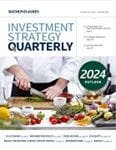First Trust Monday Morning Outlook
Brian S. Wesbury - Chief Economist
Robert Stein, CFA - Dep. Chief Economist
February 5, 2024
On the surface, there’s much to like about the job market. But when you get into the details, it’s not quite as strong and some things don’t add up.
Here’s what to like.
The establishment survey answered by a sample of businesses showed that nonfarm payrolls increased 353,000 in January, easily beating the consensus expected 185,000, the largest gain in a year, and coming in higher than the forecast from every economics group (that filed a forecast with Bloomberg). Meanwhile, payroll gains were revised up by 126,000 for November and December, bringing the net gain, including revisions, to 479,000. In the past year, payrolls are up 2.9 million or 244,000 per month.
We like to follow payrolls excluding government (because it's not the private sector), education & health (because it rises for structural and demographic reasons, and usually doesn’t decline even in recession years), and leisure & hospitality (which is still recovering from COVID Lockdowns). That “core” measure of payrolls rose 194,000 in January, which is the best month since mid-2022.
That same payroll survey showed that average hourly earnings – cash earnings, excluding irregular bonuses/commissions and fringe benefits – rose 0.6% in January and are up 4.5% versus a year ago. The Federal Reserve might not like that – the odds implied by the futures market that the Fed will cut rates by the end of the May 1 meeting went down substantially – but it is good news for workers and means wage growth per hour is out-stripping inflation.
Meanwhile, the survey that samples US households showed that the unemployment rate remained at 3.7%.
But here are the details and figures that make us wary about just accepting all the good news at face value.
First, the same payroll survey showing strong job growth is showing a concerning drop in the number of hours per worker. Workers in the private sector worked an average of 34.6 hours per week in January 2023; this January they were down to 34.1. Average weekly hours haven’t been this low since March 2020, with the onset of COVID.
As a result, even though total jobs are up 1.9% in the past year, total hours worked are up only 0.3%. To put this in perspective, a 0.3% increase in private-sector jobs in the past year would have meant private payroll gains of 33,000 per month, not the 194,000 per month we experienced. (A 0.3% gain in jobs is what would have happened if businesses had hired workers to fill the extra hours they needed but kept the number of hours per worker the same.)
Second, the household survey measure of employment hasn’t been rising nearly as fast as payrolls, which is something that has happened in the past prior to recessions. As we noted earlier, nonfarm payrolls (which includes government workers) are up 244,000 per month in the past year. But the household survey (smoothed for recent population adjustments) is up only 101,000 per month in the past year. That’s a very large gap by historic standards.
Another issue is the oddity of having payroll growth of 244,000 per month in the past year while the unemployment rate has been so low. Since February 2001, right before the 2001 recession, payrolls have grown at an average pace of 91,000 per month. Since February 2020, right before COVID, payrolls have grown at an average pace of 115,000 per month. Those longer-term averages make sense given a growing population in the context of an aging workforce.
But how then can we have payroll growth so much faster in the past year, particularly when the unemployment rate is already so low? Usually job growth gets slower when the jobless rate is near bottom.
One theory can explain this, however: that the US economy has been temporarily boosted by having the government run a larger budget deficit, including the effects of the CHIPS Act, infrastructure bill, and the Inflation Reduction Act. But that artificial boost should soon come to an end. And when it does job growth should slow sharply, as well.
A strong job market is a good thing, but it doesn’t mean a recession can’t start soon. Payrolls are up 1.9% in the past year. But they were up the same in the year ending in January 1990 and a recession started mid-year. They were up 1.3% in the year ending January 2001 and a recession started in Spring 2001. The flu starts when you’re feeling good and it’s normal for a recession, like the flu, to come when the economy looks fine.
The attached information was developed by First Trust, an independent third party. The opinions are of the listed authors at First Trust Advisors L.P, and are independent from and not necessarily those of RJFS or Raymond James. All investments are subject to risk. There is no guarantee that these statements, opinions, or forecasts provided in the attached article will prove to be correct. Individual investor's results will vary. Past performance does not guarantee future results. Forward looking data is subject to change at any time and there is no assurance that projections will be realized. Any information provided is for informational purposes only and does not constitute a recommendation. Investing involves risk and you may incur a profit or loss regardless of strategy selected.























